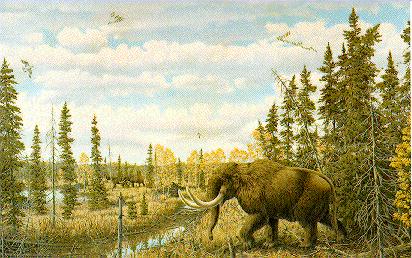|
|
|
|
|
By the time Paleoindian people arrived in Illinois, the midcontinental glaciers had retreated northward into the upper Great Lakes and Canada. The glacial ice had begun to melt due to a slight increase in temperature, but the climate in Illinois was still cooler than today. When compared to our weather, the growing season (Spring and Summer) in a typical Paleoindian year may have been up to one month shorter; the annual amount of snowfall was greater: and the mean July temperature may have been as much as 2.7o C (5o F) cooler than it is today.
In large part, climate determines the plants and animals found in Illinois. Even slight changes in climate can result in major differences in the abundance and distribution of species. As the Ice Age ended, Illinois' landscape was transformed from tundra to spruce woodland to deciduous forest, like that found in Illinois today.
 |
 |
|
Midwestern United States landscape 16,000 years ago.
|
|
|
|

